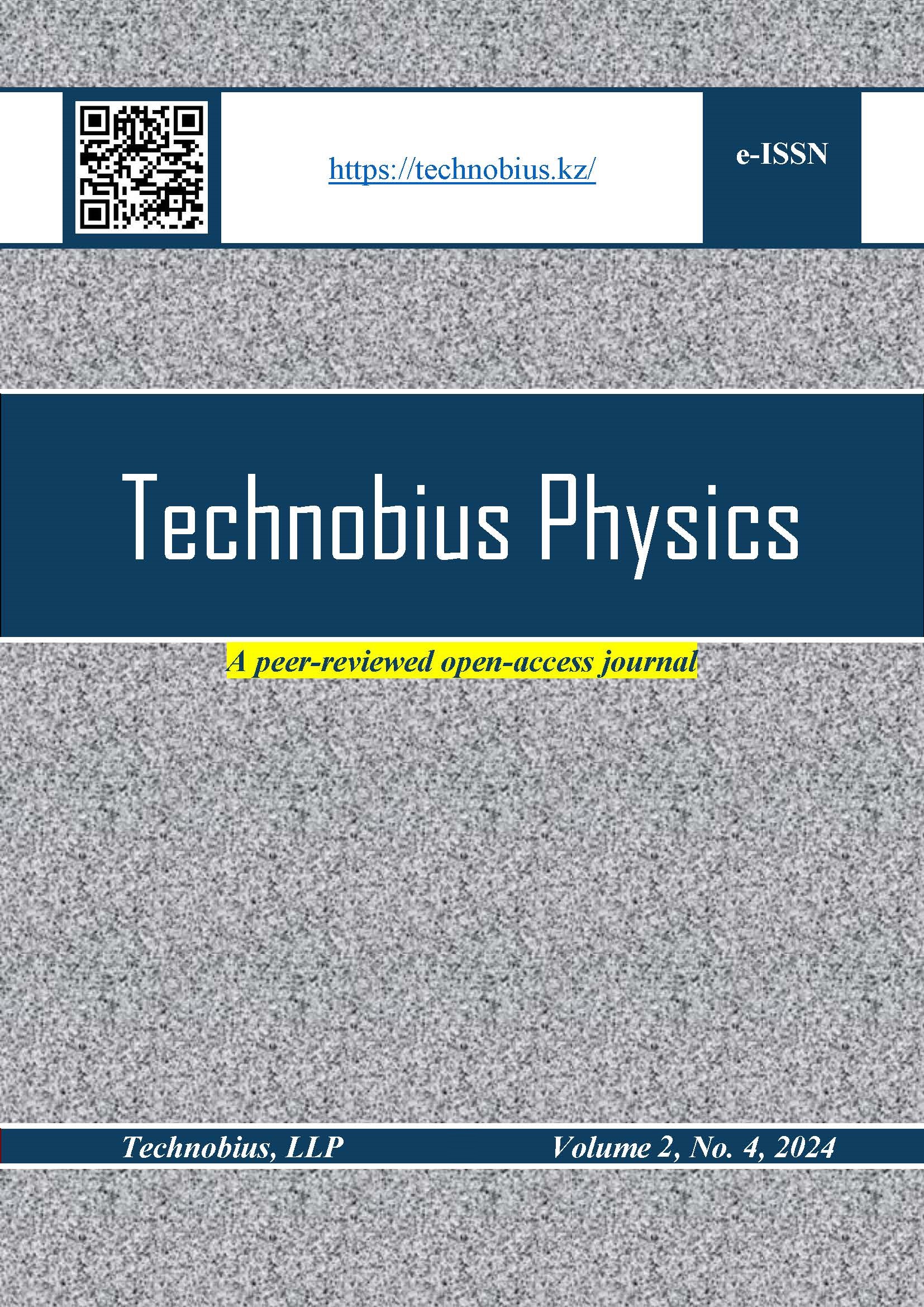Investigation of the electrical properties and carrier concentration in n- and p-doped germanium
DOI:
https://doi.org/10.54355/tbusphys/2.4.2024.0022Keywords:
hall effect, germanium, charge carrier mobility, electrical conductivity, semiconductor propertiesAbstract
This study investigates the Hall effect in n- and p-doped germanium samples through experimental measurements of Hall voltage, electrical conductivity, charge carrier mobility, and carrier concentration under varying magnetic fields and temperatures. The experimental setup involved measuring Hall voltage as a function of control current, magnetic field induction, and temperature using a TSE Co, LTD company Hall-effect unit. The linear dependence of the Hall voltage on the magnetic field was confirmed, yielding regression line slopes of b = 0.144 VT−1 ± 0.004 VT−1 for n-germanium and b = 0.125VT−1 ± 0.003VT−1 for p-germanium. Corresponding Hall constants were calculated as RH = 4.8×10 m-3 /C and RH = 4.17×10 m-3 /C. Electrical conductivities were determined as σ = 53.6 S/m for n-germanium and σ = 57.14 S/m for p-germanium. The Hall mobilities were found to be μH = 0.257±0.005 m2 /Vs for n-germanium and μH = 0.238±0.005 m2/Vs for p-germanium. Carrier concentrations were n = 13.0×1020 m−3 for electrons and n =14.9×1020 m−3 for holes. From temperature-dependent measurements, the energy bandgaps were calculated as Eg = 0.50 ± 0.04 eV for n-germanium and Eg = 0.72 ± 0.03 eV for p-germanium. The experimental findings provide comprehensive insights into the electronic properties of doped germanium, highlighting its behavior under magnetic fields and varying temperatures, with precise parameter evaluation crucial for semiconductor applications.
Downloads
Metrics
References
R. A. Masut, “Poisson’s equation in semiconductors: impact of charge depletion on Hall effect measurements,” Can. J. Phys., vol. 101, no. 3, pp. 141–149, Mar. 2023, doi: 10.1139/cjp-2022-0158. DOI: https://doi.org/10.1139/cjp-2022-0158
N. Saleh and A. H. Qureshi, “Conductivity tensor and hall effect in magnetic semiconductors,” J. Appl. Phys., vol. 42, no. 11, pp. 4313–4314, Jan. 1971, doi: 10.1063/1.1659772. DOI: https://doi.org/10.1063/1.1659772
T. Bauer, J. Kolb, A. B. Hummel, H. G. Roskos, Y. Kosevich, and K. Köhler, “Coherent hall effect in a semiconductor superlattice,” Phys. Rev. Lett., vol. 88, no. 8, pp. 86801/1-86801/4, Feb. 2002, doi: 10.1103/PhysRevLett.88.086801. DOI: https://doi.org/10.1103/PhysRevLett.88.086801
C. A. Stephenson et al., “Band structure of germanium carbides for direct bandgap photonics,” 2016 IEEE Photonics Soc. Summer Top. Meet. Ser. SUM 2016, pp. 53–54, Aug. 2016, doi: 10.1109/PHOSST.2016.7548543. DOI: https://doi.org/10.1109/PHOSST.2016.7548543
M. M. Dettling et al., “Carrier mobilities in heavily doped pseudomorphic Ge1-x Snx-epilayers,” 2020 43rd Int. Conv. Information, Commun. Electron. Technol. MIPRO 2020 - Proc., pp. 17–21, Sep. 2020, doi: 10.23919/MIPRO48935.2020.9245273. DOI: https://doi.org/10.23919/MIPRO48935.2020.9245273
X. Li et al., “Optical bandgap anomaly with tuning dimensionality in germanium perovskites: Interplay between quantum confinement and lone pair expression,” Chem, vol. 10, no. 3, pp. 891–909, Mar. 2024, doi: 10.1016/j.chempr.2023.11.011. DOI: https://doi.org/10.1016/j.chempr.2023.11.011
M. A. Razali, A. J. Smith, C. Jeynes, and R. M. Gwilliam, “Temperature-dependant study of phosphorus ion implantation in germanium,” AIP Conf. Proc., vol. 1496, pp. 193–196, Jan. 2012, doi: 10.1063/1.4766522. DOI: https://doi.org/10.1063/1.4766522
J. Satgé, “Some applications of germanium and its derivatives,” Main Gr. Met. Chem., vol. 27, no. 6, pp. 301–307, Jan. 2004, doi: 10.1515/MGMC.2004.27.6.301. DOI: https://doi.org/10.1515/MGMC.2004.27.6.301
K. Li, K. H. Kong, H. Gamble, and M. Armstrong, “Ultra-shallow emitter formation for germanium bipolar transistor by diffusion from polycrystalline germanium,” 2011 Int. Semicond. Device Res. Symp. ISDRS 2011, p. 2011, doi: 10.1109/ISDRS.2011.6135275. DOI: https://doi.org/10.1109/ISDRS.2011.6135275
M. Mederos, S. N. M. Mestanza, R. Lang, I. Doi, and J. A. Diniz, “Germanium nanoparticles grown at different deposition times for memory device applications,” Thin Solid Films, vol. 611, pp. 39–45, Jul. 2016, doi: 10.1016/j.tsf.2016.05.026. DOI: https://doi.org/10.1016/j.tsf.2016.05.026
K. L. Guo, H. H. Chen, X. M. Huang, T. H. Hu, and H. Y. Liu, “Solar broadband metamaterial perfect absorber based on dielectric resonant structure of Ge cone array and InAs film,” Chinese Phys. B, vol. 30, no. 11, p. 114201, Jan. 2022, doi: 10.1088/1674-1056/abf91e. DOI: https://doi.org/10.1088/1674-1056/abf91e
Downloads
Published
How to Cite
License
Copyright (c) 2023 Natalya Voronena, Galina Troshina

This work is licensed under a Creative Commons Attribution-NonCommercial 4.0 International License.








